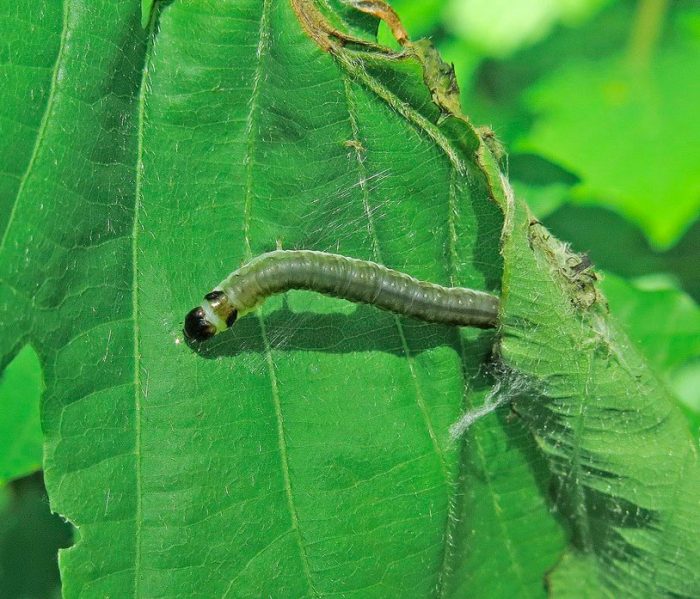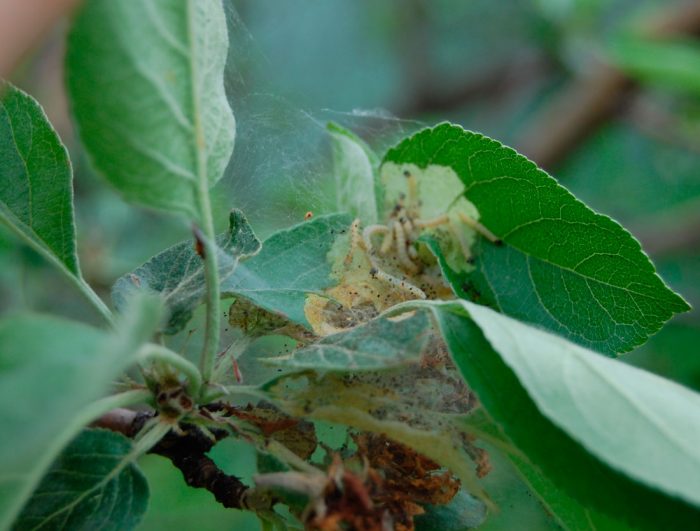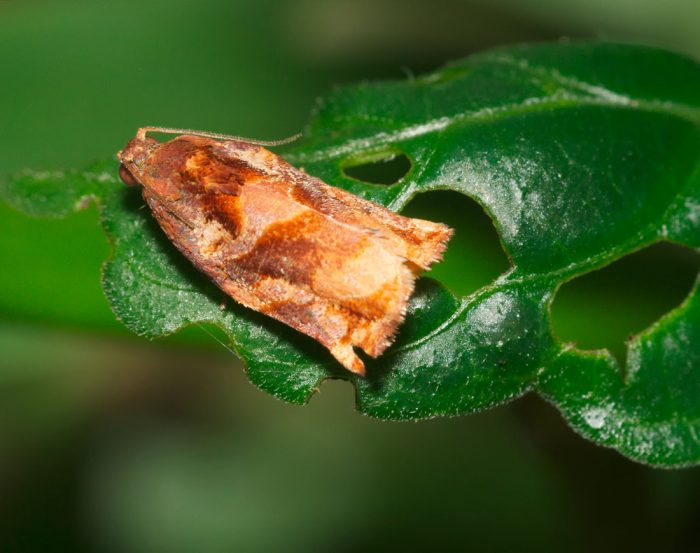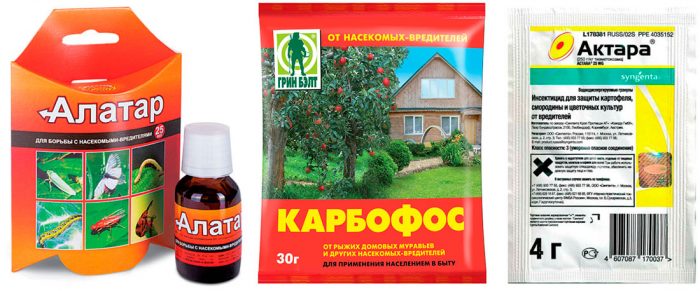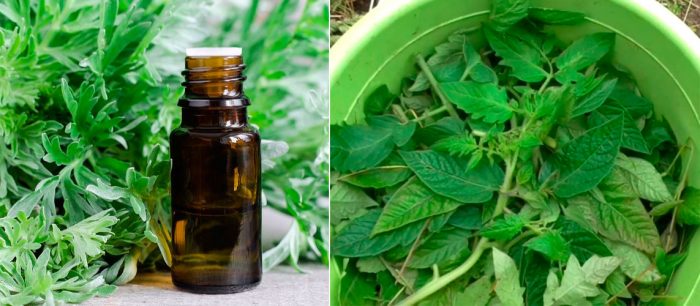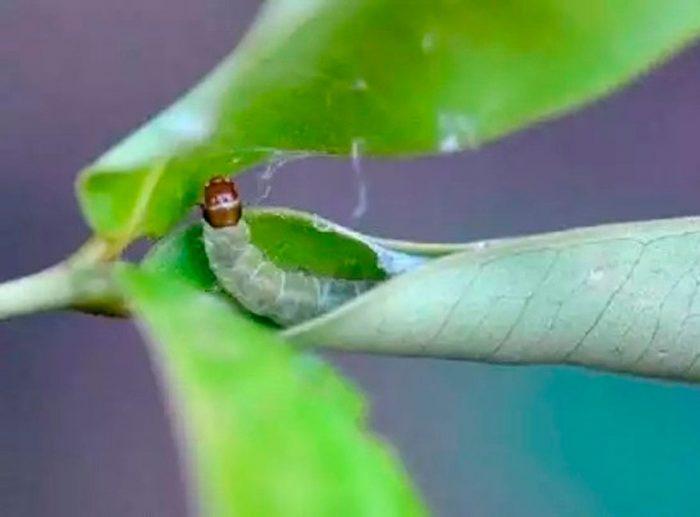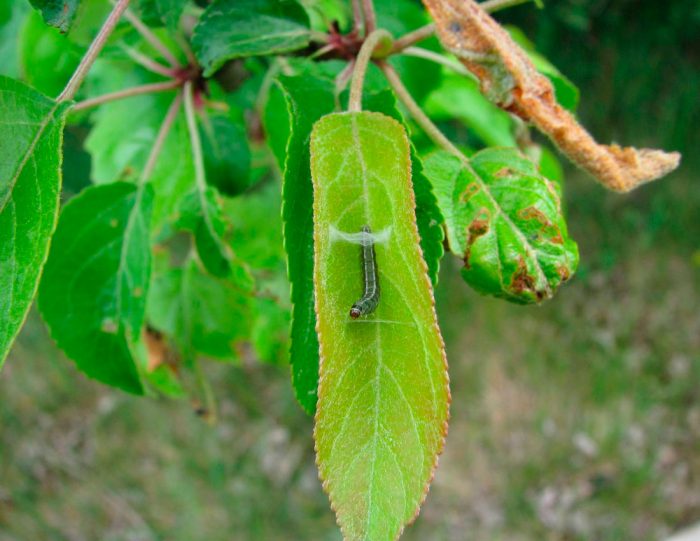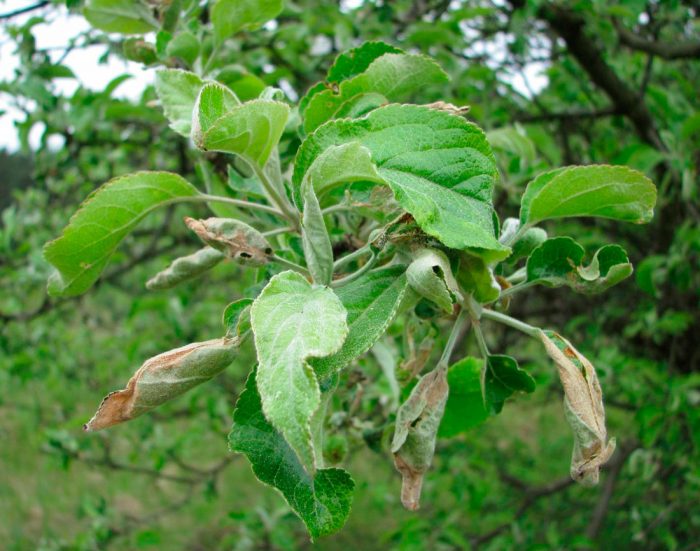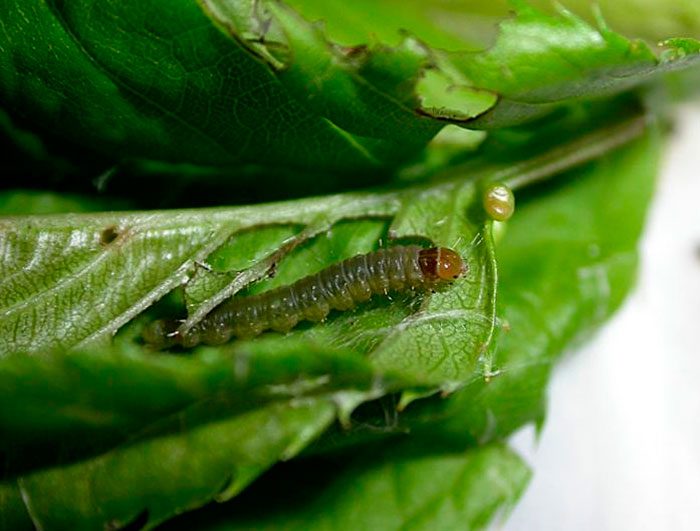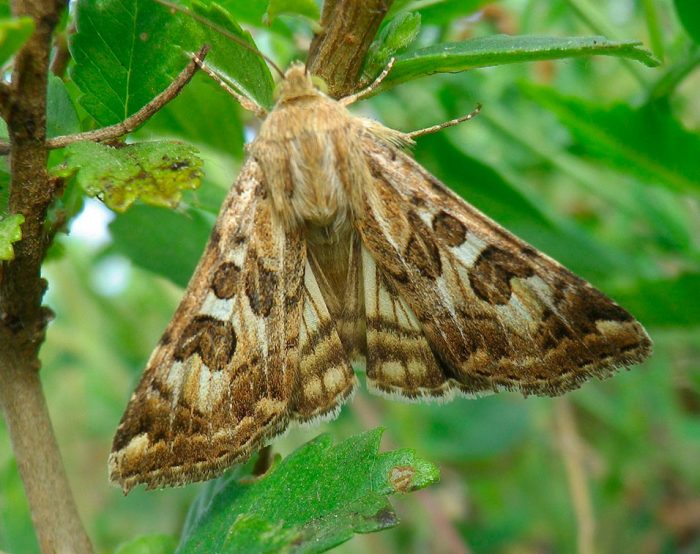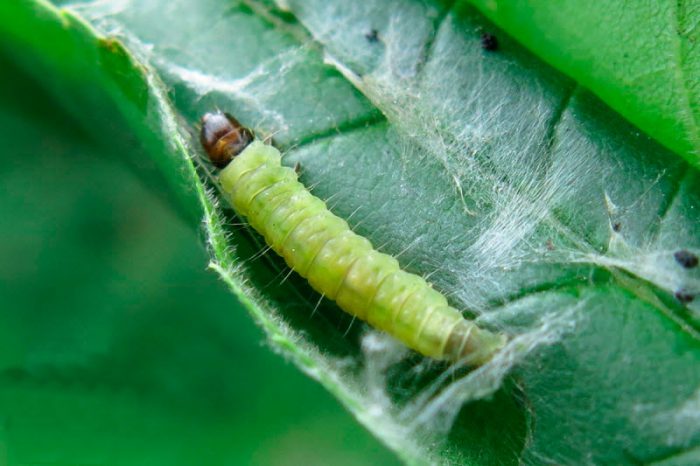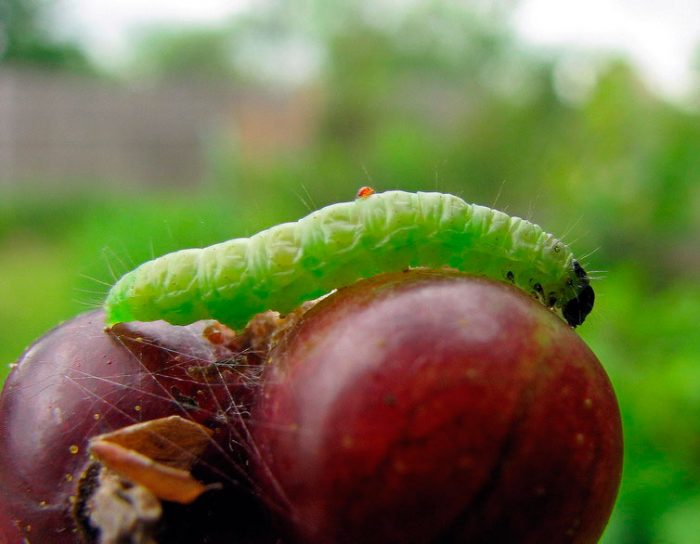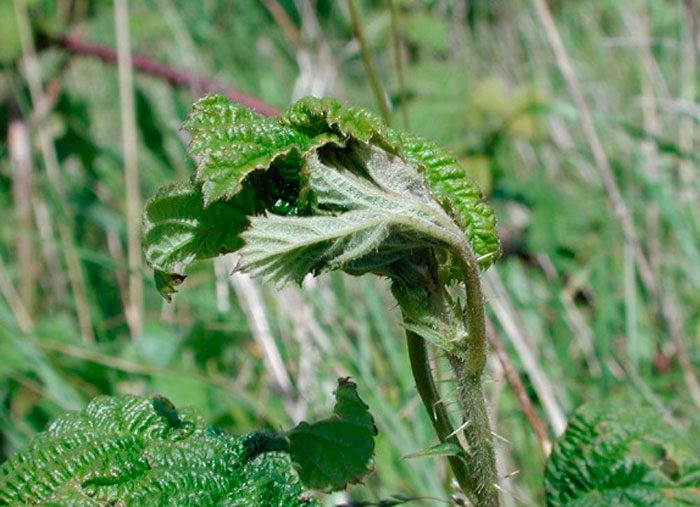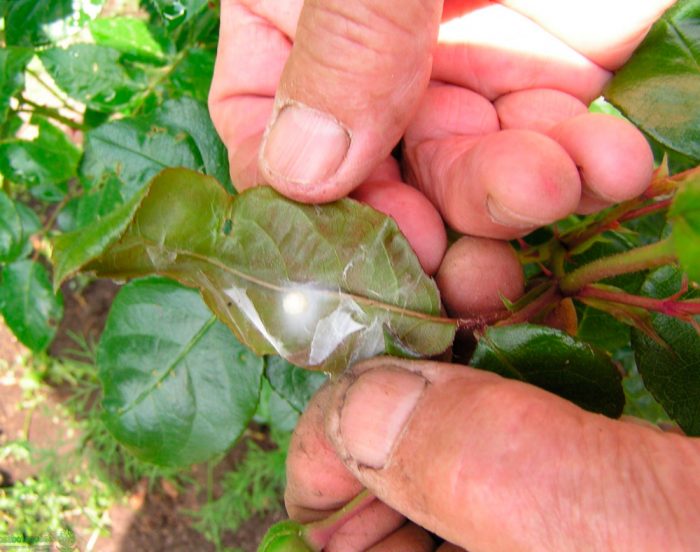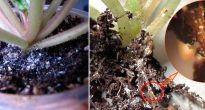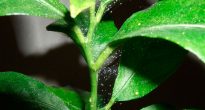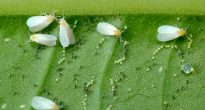The leafworm (Tortricidae or Olethreutidae) is a member of the butterfly family, which includes more than 1,000 genera and approximately 10,000 species. It can be found in any part of the world, but most of the varieties are found in the tropical forests of Asia.
Content
Features of the leaf roll
The leafworm butterfly is outwardly similar to a moth or moth. Its wingspan does not exceed 25 mm. As a rule, her body is thick and has a dense covering, consisting of hairs. The wings fold horizontally on the back. The length of the practically naked caterpillars of these butterflies varies from 10 to 20 mm, they have 16 legs, a head of brown or black color and a pale green or light yellow body. On the belly rings of the caterpillars there is a belt on which hooks are located. It is the caterpillars, not the adult butterflies, that harm the plants.
In a rather large family of leaf rollers, only a couple of genera stand out best of all, namely: the shoots, they devour the shoots and buds of conifers and moths - they harm garden shrubs and trees. All other pests belonging to this family damage almost all parts of various crops, both aboveground and underground (roots). Below it will be described in detail about moth moths.
The leafworm is capable of very much harm to garden shrubs and trees, it damages the foliage of plants. Caterpillars hide in the leaves and wrap them in tubes or bundles, while they pull them together with a web. Since there are a huge number of different types of leaf rollers, which have a lot of differences among themselves, then in each of the sections a specific type of leaf rollers will be described that can harm a particular garden shrub or tree.
Fighting the leaf roll in the garden
There are three ways to deal with the leaf roll: chemical, mechanical and biological. Thanks to mechanical methods of struggle, it is possible to destroy the caterpillars of this pest or create an obstacle that will protect the site from the whitefly. These methods include: cutting and burning foliage folded by a pest, and also shaking off the caterpillars from the plant.Also, in order to get rid of a harmful insect mechanically, you can use trapping belts and various traps, which are intended not only for collecting, but also for destroying leaf rollers. Such devices do not cause any harm to both animals and humans, and they also do not pollute nature.
Biological methods of dealing with such an insect involve the use of its natural enemies for this. Or rather, it is recommended to attract birds to the site. The main enemy of leaf rollers is the titmouse. It destroys both adult butterflies and caterpillars. In order to not only attract it to the site, but also to keep it on it, it is recommended to hang feeders on the trees in the fall, in which unroasted seeds and unsalted bacon are placed.
The most effective are chemical methods of pest control, with the help of which both butterflies and their caterpillars can be exterminated. But in this case, it must be taken into account that such a pest can very quickly adapt to toxins, in this regard, the preparations used for treatment must be regularly replaced or alternated. In addition, the toxins that make up the chemicals, during the spraying of the plants, end up on the surface of the fruits, and if a person eats them, they can harm his body. In this regard, experts advise using chemicals only when the number of leaf rollers is above the harmfulness threshold: if, when examining one branch, 5 or more caterpillars were found on it, this means that the plant must be sprayed with a special insecticidal preparation.
It is necessary to fight the leafworm not only on those plants on which it was seen. All trees and shrubs should be treated, because the larvae of such an insect can easily move to another plant, simply by slipping out of the folded foliage. In addition, we must not forget about preventive measures that will help protect the garden from the appearance of this pest. To start the fight against the pest in a timely manner, you need to inspect garden crops every day. The fact is that while there are few pests, it is much easier to get rid of them.
An adult butterfly is much more difficult to kill than a leafworm caterpillar. What tools are recommended to be used to process a particular crop from a leaf roll will be described in detail in other sections of this article. However, it should be noted that if the caterpillars managed to wrap themselves in foliage, then even the most powerful insecticide will not be able to destroy them. Therefore, such folded leaves with a pest are cut and burned.
Chemicals
All insecticidal preparations used to combat the leafworm are divided into contact and systemic. Contact agents are less toxic, but they are also not very effective. Systemic insecticides are more effective, but they are also relatively more expensive.
For prevention purposes, as well as in the event that few pests are found in the garden, the following chemicals are most often used:
- Alatar... It is a versatile insecticidal agent. To prepare a working solution, which is used for spraying garden shrubs and trees, combine one bucket of water and 3-5 milligrams of the drug.
- Karbofos, or Fufanon Is a broad-spectrum insecticidal preparation. Prepare the solution as follows: 1 liter of water is combined with 1 milligram of the agent, and in special cases the amount of insecticide is increased to two milligrams.
- Dursban... Dissolve 10 to 20 milligrams of this insecticidal acaricidal agent in one bucket of water.
- Atom, Landing, Ditox and Binom... All of these drugs are broad-spectrum insecticides. A solution is prepared for processing; for this, 1 liter of water is combined with 1 ml of the product.
- Aktara... This broad-spectrum insecticidal agent is also used in the fight against leafworm. To spray the bushes, prepare a solution - 8 milligrams of the drug is taken for one bucket of water.
- Actellic... Insectoacaricidal preparation of intestinal action. For 1 liter of water, 1 ml of the product is taken.
Such biologically active agents as: Dendrobacillin, Lepidocid and Bitoxibacillin also quite effectively destroy caterpillars.
It is quite difficult to get rid of the leaf roll, in this regard, the plants will have to be sprayed several times with a break of 1–1.5 weeks.
In the case when there are a large number of pests on garden crops, then it is recommended to use more powerful means to combat them. The larvae hidden in the leaves are exterminated with synthetic pyrethroids, for example: Ivanhoe, Alfatsin, Fatrin, Fastak and Akkord. When using these funds, you must strictly follow the instructions (see the package), while the air temperature should not exceed 23 degrees, if it is hotter, the drugs will not work. Remember that pyrethroids are very toxic to humans, so experts advise using them only when other methods have proved to be ineffective. You can also quickly get rid of the pest with the help of pesticides, for example: Inta-Vir, Rovikurt, Fury and Kinmix. However, these funds are also very dangerous for humans.
Folk remedies
In the event that there are not too many pests on trees and bushes, then you can try to exterminate them with the help of folk remedies. There are several folk remedies that are quite effective in combating the leaf roll, but at the same time are absolutely safe for both humans and animals. For example:
- Wormwood decoction... To prepare it, you need to combine 10 liters of water with 0.7–0.8 kg of dry wormwood or with ½ part of a bucket of chopped fresh grass. The mixture should be infused for two days, after which it is boiled for 30 minutes over low heat. Bring the volume of the cooled and strained product to 10 liters. Before processing, the product is diluted with water in a 1: 1 ratio.
- Infusion of tobacco... A pound of tobacco or tobacco dust is added to a bucket of hot water. The infusion will be ready in 2 days, it is filtered with gauze and squeezed out. The product is diluted with water in a 1: 1 ratio. Before processing, 40 g of soap crushed on a grater is dissolved in each bucket of the finished product (you can take liquid soap). This infusion is toxic to humans, therefore, during processing, do not forget about safety measures.
- Tomato leaf decoction... A bucket of water is combined with four kilograms of finely chopped roots and green fresh tomato tops, the mixture is allowed to brew for three to four hours. Then it is boiled for half an hour over low heat, when the product cools down, it is filtered, while the plant residues must be squeezed out. In tightly closed glass bottles, the broth can be stored for 12 months, but only in a cool place. Before use, the broth is diluted with water (1: 1), while 40 grams of crushed soap is placed in every 10 liters of the finished solution.
- Infusion of potato tops... A bucket of warm water is combined with four kilograms of fresh potato tops (dry tops are taken 2 times less). The infusion will be ready after 3 or 4 hours. When it is strained, 40 grams of soap is put into it.
These folk remedies are quite good at fighting caterpillars if the bushes and trees are sprayed with them shortly before they bloom and at the end of flowering. To get rid of adults of leaf rollers (butterflies), you will need a molasses solution, jam that has begun to ferment, dried fruit compote or bread kvass. Fill a 1/3 part of a 1 liter glass jar with it, then hang it in the evening on a tree at least one and a half meter high. There the "trap" must stay the night.In the morning, remove the jar, as not only pests, but also beneficial insects can get into it, and adult leaf rollers do not fly in the daytime, but hide on tree branches and trunks.
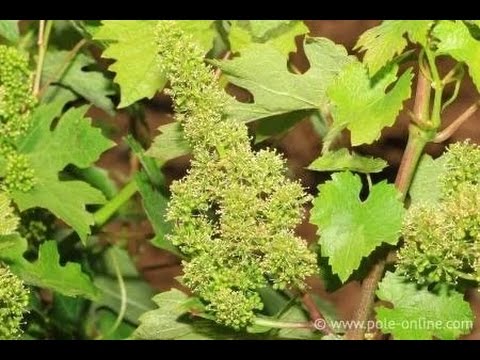

Watch this video on YouTube
Prevention measures
As a rule, absolutely healthy and strong plants are bypassed by pests. And first of all, leafworms settle on crops weakened by disease or inappropriate care. Remember the agrotechnical rules of crops, and also provide them with timely care, for this plant you need to weed, water, cut and feed on time. Make sure that the crowns of plants are not overly thickened, and also that there is a sufficient amount of nutrients and moisture in the soil, but remember that both their lack and excess can harm both shrubs and trees. If the near-trunk circle is overgrown with grass, then this increases the likelihood of a leaf roll. Make sure that the soil in the trunk circle is always loose.
In order to prevent the spread of leafworm caterpillars in the garden, you need to remove loose leaves and fruits from under the plants every day, especially if the moth has settled on them. In trees in early spring, the bark is cleaned, for this, dead parts are removed, after which the surface of the stem is covered with milk of lime on top, which is mixed with a chalk solution or copper sulfate, and Karbofos (2%) is also added to it. Try to prevent frost damage and mechanical damage on trees.
Preventive treatments
In order to prevent the appearance of leaf rollers on the garden plot, experts advise systematically to carry out preventive treatments. For the first time this season, the plants are treated in early spring, immediately after the skeletal branches and tree trunks are cleaned and whitewashed. The treatment is carried out before sap flow begins, while the air temperature should be at least 10 degrees, but if it is colder outside, the larvae will hide under the bark, and the drug used for spraying will not be able to act on them.
In order to prevent, plants are treated with agents such as Kinmix or Decis, and do not forget to follow the instructions. These funds are also used for subsequent treatments, which are carried out shortly before the plants bloom and immediately after flowering. During the growth of fruits, fruit shrubs and trees are also sprayed for prophylaxis, for this you can use Karbofos, Iskra, Kinmix, Fury, Kemifos, Citkor or Decis. After that, the crops are no longer sprayed with chemicals, but you still need to regularly remove loose fruits and leaves, pick off foliage rolled with a leaf roll from the plants, and also regularly hang traps and use trapping belts to tie trees. When leaf fall ends, clear the garden area of foliage and loosen the soil in the tree trunk circles. Then shrubs and trees, as well as the surface of the ground under them, are sprayed with copper sulfate or Bordeaux mixture.
Leaf roll on trees
Leaf roll on apple tree
Several types of leaf rollers can settle on an apple tree:
- Kidney leaf roll, or vertebrate... The front wings of such a butterfly are whitish-yellow in color. The basal field has a brownish-gray color with a bluish tint, and almost near the upper edge there is a large mirror, which is surrounded by a pair of glossy lead-gray stripes.
- Bunch roll... The front wings of the insect are brown and have a pattern consisting of transverse stripes of a light shade, which is diluted with pale blue and yellow spots.
- Eastern moth... On the wings of a dark brown shade, white streaks are located along the front edge.The upper part of the wings has a velvety black edging. The color of the hind wings is paler, brownish-gray.
- Hawthorn leafworm... In males of such a moth, the front wings are pale yellow, and in females they are brownish-gray. The wings are decorated with a pattern, in males it is light brown and washed out, and in females it is a darker shade. The color of the hind wings is paler, while the females have a light rufous bloom on their surface.
- Apple moth or apple moth... A gray moth, whose wingspan can vary from one and a half to two centimeters. The length of the pinkish caterpillar is about 1.8 cm, its head is brown. The brownish-yellow pupa reaches 0.9 to 1.2 cm in length.
In addition to these species, plum, oak and pear moths, currant and fruit moths also sometimes settle on the apple tree (their description can be found below). The caterpillars of such an insect harm the foliage, buds and fruits of this culture.
They fight a leaf roll that has settled on an apple tree in various ways, while preventive measures should not be neglected. From spring until the beginning of the active growth of apple fruits, it is recommended to spray it with chemical agents, later, folk remedies that are less dangerous to humans are used for their treatment, and they do not forget about mechanical methods of dealing with the pest.
At the beginning of the season in early spring, when it is not colder than 10 degrees outside, spray the tree with Decis solution (1 milligram per liter of water) or Prophylactin (500 ml per bucket of water). For one adult plant, no more than half a bucket of solution is taken. In the future, you will need 2 more spraying with agents of a similar action (Landing, Karbofos, Tod, Ditox, etc.), they are carried out shortly before flowering and immediately after its end. All foliage folded into a ball or tube must be cut off, but do not allow the caterpillar to run away. It is recommended to destroy this foliage with fire, while you need to work with gloves. In the middle of summer, after the caterpillars hide, it will be very difficult to destroy them using chemicals. At this time, the apple tree and the surface of the soil under it are sprayed with pyrethroids, for example: Alfacin, Ivanhoe, Akkord, Altyn, Fatrin or Fastak. The tree should be processed with these means only when the air temperature outside is no more than 23 degrees.
When the fruits just begin to gain weight, spraying the apple tree with pesticides must be stopped. After that, the plant can be saved from leaf rollers only by mechanical and biological methods, for example, traps and trapping belts can be used. Timely clean the surface of the soil under the tree from loose fruits and foliage. If there is such a need, then spray the plant with one of the folk remedies.
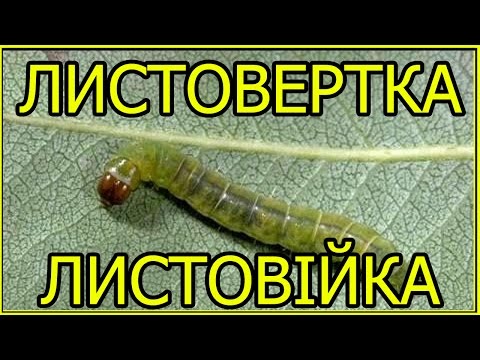

Watch this video on YouTube
Leaf roll on a pear
The following types of leaf rollers can settle on a pear tree: apple, plum, pear, oriental, bunchy, frozen, rose, hawthorn and oak moth.
- Pear leaf roll (moth)... The front wings of this butterfly are of a dark gray shade, they are decorated with wavy transverse stripes. On the forewings, there is a brownish-brown speck on the upper edge. The color of the hind wings is grayish-brown. A dark line runs at the base of the gray fringe.
- Oak leaf roll or green leaf roll... The abdomen of the butterfly is gray, and the head is pale yellow. The wings can be yellowish green or light yellow with blurred edges.
Leaf rollers are able to leave the gardener without a crop, because they devour the young growth of the pear, while the buds do not appear, since they do not have time to form. In addition, the tree on which the moths settled is greatly weakened, which has an extremely negative effect on its frost resistance.
Prevention measures regarding the appearance of a leaf roll in this case, the same ones that are used when growing an apple tree, namely:
- In early spring, clean the bark by removing dead areas from it. Then whiten the base of the skeletal branches and the stem with a solution of lime or chalk.
- When cracks and frost holes are found in spring, they are cleaned to healthy tissue. Then the problem area is disinfected with a solution of copper sulfate (1%), and then it is coated with garden varnish.
- The first time a tree is treated for prevention in early spring, while the buds are still sleeping, while the air temperature outside should be at least four degrees. To do this, use the Preparation 30, it effectively fights against harmful insects that have wintered both in the upper layer of the soil and in the bark of the plant. Further processing for preventive and therapeutic purposes is carried out only by such means as: Landing, Binom, Decis, Atom, Terradim, and you can also use the preparations described in the section about the apple tree.
After the fruits begin to actively gain weight, all chemical treatments are stopped. Further, it will be possible to use only folk remedies in the fight against the pest, as well as various mechanical methods, for example:
- cleaning the near-trunk circle from weeds and loosening the soil surface in them;
- trimming folded leaves containing caterpillars;
- regular cleaning of loose leaves and fruits;
- installation of baits, for this, jars filled with fermented sweet mixture are hung on the branches;
- use of trapping belts made of corrugated paper or burlap.
In autumn, when leaf fall ends, the garden plot must be cleared of loose leaves, which are then burned.
Plum roll
The same types of leaf rollers can settle on the plum as on the apple or pear tree, namely: apple, bunch, oak, plum, hawthorn, bud, oriental, fruit, etc.
- Plum roll (moth)... The front wings of this butterfly are brownish-gray with a purple tint, they are decorated with a blurry mirror, on which there are dots and strokes of black color. The brownish-gray hindwings are colored paler at the base.
- Fruit roll, or changeable leaf roll... The wingspan of the moth is from 1.7 to 2.1 cm. The color of its wings is dark gray or brownish-brown with a pale blue tint, white spots are located closer to the inner edge. The upper part of the wings is 1/3 painted almost white; along the outer edge they are decorated with brown, black or grayish-blue spots and stripes. In brownish-gray hindwings, the anterior margin of a paler shade.
In order to protect the plum from this harmful insect, you need to start fighting with it in early spring:
- The base of the skeletal branches, as well as the plum stem, must be cleaned of dead bark fragments. Then their surface is painted using a lime solution with copper sulfate or a chalk solution mixed with Karbofos.
- Preventive spraying is carried out in a timely manner before the buds open, shortly before flowering and at its end. To do this, use such means as: Decis, Preparation 30, Prophylactin, Desant, Detox, Tod, etc.
Treatment of plums with Preparation 30 is carried out when the air warms up to 4 degrees, other means will work only if it is not colder than 10 degrees outside. If there are few pests on the plant, then remove them by hand or spray the plum with any folk remedy. Experts advise to spray the plum tree with chemicals only if there are a lot of leaf rollers. The rest of the activities must be carried out according to the same plan, which is described in the sections about pear and apple trees.
Apricot leaf roll
The following types of leaf rollers most often settle on apricot, the description of which can be found above: oak, grapevine, hawthorn, apple, plum, fruit, oriental, etc.
In this case, the pest is fought in the same way as when growing a pear, plum or apple tree (see above). Remember that spraying apricots with powerful pesticides should be carried out only when absolutely necessary, when there are a lot of pests.
Peach rolls
The peach is treated against pests with the same means as the pear, apple and other fruit trees already described. If there are few insects, then folk remedies are used for spraying, and if they turn out to be ineffective, only then it is recommended to use a strong chemical.
Leafworm on grapes
Most often, grapes are harmed by such types of leaf rollers as: grape, biennial and grape.
Grape leafworm - the wingspan of this butterfly is about 2.5 cm, its mouth apparatus is elongated. The color of the hind wings is brownish-gray, and the front ones are ocher, pale green or shiny like brass. On the front wings there are oblique stripes of dark brown color, they are more clearly visible in males, and in females they may be absent or barely distinguishable. Caterpillars of a greenish-gray color with a brown head at the very beginning destroy the grape buds, and then begin to eat young leaf plates, and also create shelters for themselves, for this, bending the edges of the leaves and entangling them with cobwebs. Just one caterpillar, making itself a refuge, is capable of wrapping several sheet plates at once. They dry out over time, turn red and turn brown. Caterpillars eat away the foliage, of which only veins remain, and also injure the clusters and inflorescences.
You can start processing grapes from this pest already in the last winter weeks. To do this, use a solution of Nitrafen or DNOC, which is abundantly sprayed both on the plants themselves and on the supports, since the leafworm can also overwinter there. During the growing season, for the treatment of the vineyard from the pest, you can use such agents as: Tsidial, Sumicidin, Metaphos, Fozalon, Ekamet or Tsimbush, lepidocid, Lepidobactocid, Bitoxibacillin, Fastak. The last time such a plant can be sprayed with chemicals no later than 30 days before harvest. In addition to treatments, you also need to systematically inspect the bushes and cut off folded foliage along with the caterpillars, which is then destroyed.


Watch this video on YouTube
Currant leafworm
Currant bushes can be harmed by the same types of leaf rollers that also settle on fruit trees. Currant leafworm - the wingspan of such a butterfly is about 2.5 cm, its abdomen is brownish, and there is a dark brown pattern on the frontal wings, which is a triangular mark. Over time, it gradually turns green and becomes almost emerald. Only one female is capable of laying about 150 eggs, of which caterpillars will soon appear. They not only feed on foliage, but also twist it into a tube. If there are a lot of pests on the bush, then the gardener can lose almost the entire crop (up to 80 percent).
In order to save the currant from this pest, it is recommended to spray it with folk remedies. To do this, you can use both decoctions and infusions made from plants that have a pungent odor or pungent juice, for example: wormwood, tomato or potato tops, garlic and onions. Do not forget to regularly loosen the surface of the soil under the plants, and also clean it of loose leaves, which must be destroyed. In the event that these methods prove to be ineffective, then you will have to use the chemicals that were listed in the previous sections.
Raspberry leaf rollers
Most often, raspberries are harmed by the following types of leaf rollers: rose, currant, omnivorous, hawthorn, reticulated, willow, variegated, frozen and bud. But raspberries do not suffer from such a pest as much as currants.
- Frozen leaf roll - This is a small butterfly, whose wingspan is about 2.2 cm. In males, the front wings are painted in a grayish-red or grayish-brown shade, while in the upper part there are a pair of round spots of a dark color. The color of the hind wings is gray. The forewings of the females are gray and underdeveloped; on their surface there is a dense covering, consisting of long dark-colored hairs. Females have no hind wings. The caterpillar is painted in a dirty green shade, on the sides it has paler stripes, the head is brownish-yellow.
- Mesh leafworm - the wingspan of such a butterfly is about 2.2 cm. The front wings are buffy-yellow or brownish, they are decorated with a pattern of brownish-red or rusty-brown color. The pale brown hindwings are translucent.
Destroy the leaf roll on raspberries in the same way as on currants (see above). Thin bushes in a timely manner, tear off and burn foliage, pull up weeds and loosen the soil around the plants. Try, if possible, to use folk remedies for treating bushes, which are practically harmless to humans.
Leaf roll on roses
Sometimes leaf rollers settle on flower crops. On the bush affected by the pest, foliage can be found folded like a cigar. Most often, rose leafworms settle on roses, which are a small butterfly. In males, the wingspan is about 1.9 cm, and in females - up to 2.2 cm. The ocher-golden or dark brown front wings are decorated with narrow transverse wavy stripes and several spots, which are painted in a darker shade. The length of a translucent caterpillar can reach up to 20 mm, its head is brown and shiny. The caterpillar is colored in various shades of green. The eggs are able to survive when the temperature drops to minus 27 degrees, but if the winter period turns out to be little snow, then they may die. Caterpillars gnaw at the foliage, of which only skeletons remain, then they move to the upper part of the shoots and gnaw the buds, after which they begin to eat the flowers.
If there are few pests on the flowers, then inspect the bushes and tear off all folded foliage, which is then destroyed. In extreme cases, plants can be sprayed with Aktara's solution (1 ml of water per liter). Also, for spraying, you can use products that include pyrethrin, for example: Ivanhoe, Alfacin, Fastak, etc.


Watch this video on YouTube

